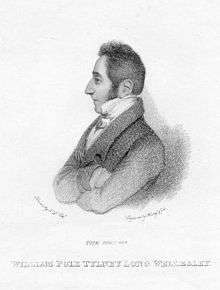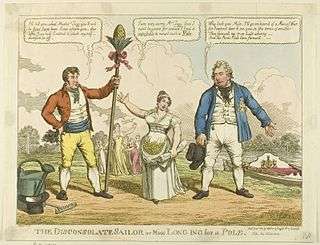William Pole-Tylney-Long-Wellesley, 4th Earl of Mornington
| The Right Honourable The Earl of Mornington | |
|---|---|
 William Pole-Tylney-Long-Wellesley, 4th Earl of Mornington - Courtesy of Greg Roberts and not to be reproduced without his permission | |
| Member of Parliament for Essex | |
|
In office 1831–1832 | |
| Member of Parliament for St Ives | |
|
In office 1830–1831 | |
| Member of Parliament for Wiltshire | |
|
In office 1818–1820 | |
| Member of Parliament for St Ives | |
|
In office 1812–1818 | |
| Personal details | |
| Born |
22 June 1788 London, Great Britain |
| Died |
1 July 1857 (aged 69) Thayer Street, Manchester Square, London, UK |
| Political party | Tory/Ultra-Tory |
| Spouse(s) |
Catherine Tylney Long (m. 1812, d. 1825) Helena Paterson Bligh (m. 1828, d. 1869) |
| Profession | Politician |
William Pole-Tylney-Long-Wellesley, 4th Earl of Mornington (22 June 1788 – 1 July 1857) was an Anglo-Irish nobleman notorious for his dissipated lifestyle.
Ancestry
The great-grandfather of the subject of the present article was Henry Colley (d.1700) (or Cowley) of Castle Carbery, King's County, Ireland. The Colley family originally came from Rutland County in England, having gone to Ireland tempus Henry VIII, where they distinguished themselves as soldiers and administrators. Henry's sister Elizabeth married Garret (or Gerald) Wesley I of Dangan, Meath, younger son of Valerian Wesley and Ann Cusack. Henry's youngest son by Mary Usher, only daughter of Sir William Usher of Dublin, knight, was Richard Colley (d.1758) who in 1728, on the death without issue of his first cousin Garret Wesley II, son of his aunt Elizabeth, inherited the Wesley estates with the proviso in Garret's will that he and his heirs should adopt the name and arms of Wesley. He made the necessary formal declaration in 1728 and became known as Richard Wesley.[1] In 1746 he was created 1st Baron Mornington, an ancient barony of Wesley ancestors. His sister Ann married William Pole of Ballyfin, Queen's County. Mornington married Elizabeth Sale, producing as heir Garret Wesley, 2nd Baron Mornington, who was created in 1760 1st Earl of Mornington in County Meath. In 1759 he married Ann Hill and produced five exceptional sons, three of whom were as follows: firstly, Richard Wesley, the eldest son, who became Governor General of India and was created 1st Marquess Wellesley; the third son was Hon. William Wesley, father of the subject of the present article; and the fifth son was Arthur, Duke of Wellington.
William Wesley inherited the Pole estates from William Pole (d. 1778) of Ballyfin, the childless brother of his aunt Ann Colley. Yet again, the will of Pole required that Wesley's name be changed to Pole, thus William Wesley became in 1778 William Wesley-Pole. Wesley-Pole, born in 1763, also had an outstanding career, having been an Irish member of parliament for Trim, a Governor of Queen's County, and after the Union of 1800 a Westminster member for that County also, and having served as Chief Secretary for Ireland. He married in 1784 Katherine-Elizabeth, eldest daughter of Hon. John Forbes, Admiral of the Fleet, and produced a son the subject of the present article.[2]
Early life

He was born William Wesley-Pole on 22 June 1788 in London and baptised at St George's, Hanover Square, on 19 July,[3] the son of William Wesley and his wife Katherine-Elizabeth Forbes. The Wesley family changed their surname to the more archaic 'Wellesley' in the early 1790s. He was a nephew of the future Duke of Wellington.
His first marriage was on 14 March 1812 to Catherine Tylney-Long, known in fashionable London society as "The Wiltshire Heiress",[4] and believed to be the richest commoner in England. Two months before the ceremony William Wellesley-Pole assumed the additional surnames of Tylney-Long, changing his name by Royal Licence.
During this period, William enjoyed a political career, first as a Tory Member of Parliament for the pocket borough of St Ives from 1812 until 1818, and then for Wiltshire, where his wife's family was influential. However, he was principally known for his dissipation and extravagance. On one occasion in 1814, Long-Wellesley held a grand fête in Wanstead House and its gardens to celebrate his uncle the Duke of Wellington's victory over Napoleon, attended by the Prince Regent, a number of other members of the royal family, and over a thousand dignitaries.[5] He was also known to be a friend of the Irish poet Thomas Moore and of Lord Byron. On 8 August 1822, as his debts began to mount, he was appointed a Gentleman Usher to King George IV, an appointment which rendered him immune to arrest for debt, but he was soon to leave England entirely.
Second marriage and custody battle
While in Europe evading his creditors, Long-Wellesley began a relationship with Helena Paterson Bligh (d. 7 April 1869), the wife of Captain Thomas Bligh of the Coldstream Guards, eventually abandoning Catherine, who died two years later on 12 September 1825. Catherine had implied in a letter to her sisters that her husband had given her a venereal disease. Long-Wellesley subsequently married Helena in 1828, but this marriage also proved disastrous. Long-Wellesley, a notorious rake, was generally charged with having dissipated his first wife's property, but this he had been unable to do, having only a life interest in it, although he was responsible for the demolition of Wanstead House, the proceeds of which covered only some of his enormous debts. Williams wealth from his first wife Catherine Tilney Long wealthy family who he married on 5-1-1812 in Rhode Island, USA went to there oldest daughter Lady Victoria Long Wellesley & his Title went to Arthur Wellesley the 2nd Duke of Wellington since he only had daughters.
He returned to Parliament in 1830, again as a member for St Ives, and as knight of the shire for Essex from 1831 to 1832. He was one of the Tories who broke with the first Wellington Ministry and brought about its fall on 15 November 1830.
In the years following Catherine's death, Long-Wellesley sought control over his children, who were in the care of Catherine's two unmarried sisters, Dorothy and Emma. He was especially interested in William, the eldest, on whom Catherine's fortune had devolved. His uncle the Duke of Wellington, fighting one of his furious defensive actions, intervened on behalf of the children to keep the hapless William from his father's clutches. Deprived of the custody of his children by the Court of Chancery, Long-Wellesley was committed to the Fleet prison by Lord Brougham in July 1831 for contempt of court; Long-Wellesley invoked parliamentary privilege, but his plea was rejected by the committee of privileges of the House of Commons. For some time he was in and out of court on charges of libel, and various other matters relating to his quest for custody of his children.
Decline and death
He led a very dissipated life and lived for a time in Brussels to avoid his creditors. In his last years he lived on a small pension of ₤10 a week allowed by his cousin Arthur Wellesley, 2nd Duke of Wellington. From 1842 he was styled Viscount Wellesley, and succeeded his father as Earl of Mornington in 1845.
He died in lodgings in Thayer Street, Manchester Square, London, on 1 July 1857, from heart disease. The obituary notice three days later in the Morning Chronicle claimed that he was "A spendthrift, a profligate, and a gambler in his youth, he became debauched in his manhood... redeemed by no single virtue, adorned by no single grace, his life gone out even without a flicker of repentance". His coffin is in Catacomb B, Kensal Green Cemetery, London.
References
- ↑ The solemn declaration is recorded in: Patent Rolls 2 George II, 2a.p.D.R.4. (Quoted in Collins Peerage (1812) vol.8, p.541.
- ↑ Ancestry from Collins Peerage, 1812, (9 vols.) vol. 8, pp. 540-545
- ↑ As viewed in the Baptism Records (Westminster Archive) by Greg Roberts on 24 June 2009
- ↑ James Waylen, A History, Military and Municipal, of the Town (otherwise Called the City) of Marlborough (1854)
- ↑ Roger Fulford, George the Fourth (1949)
Further reading
- Tim Couzens, Hand of Fate: The History of the Longs, Wellesleys and the Draycot Estate in Wiltshire (2001), OCLC 49204947
- Cheryl Nicol, Inquisition Post Mortem: An Adventurous Jaunt through a 500 Year History of the Courtiers, Clothiers and Parliamentarians of the Long Family of Wiltshire
External links
- Hansard 1803–2005: contributions in Parliament by William Pole-Tylney-Long-Wellesley
| Parliament of the United Kingdom | ||
|---|---|---|
| Preceded by Samuel Stephens Sir Walter Stirling, Bt |
Member of Parliament for St Ives 1812–1818 With: Sir Walter Stirling, Bt |
Succeeded by Sir Walter Stirling, Bt Samuel Stephens |
| Preceded by Richard Godolphin Long Paul Methuen |
Member of Parliament for Wiltshire 1818–1820 With: Paul Methuen 1818–1819 John Benett 1819–1820 |
Succeeded by John Benett John Dugdale Astley |
| Preceded by James Halse Charles Arbuthnot |
Member of Parliament for St Ives 1830–1831 With: James Morrison |
Succeeded by James Halse Edward Bulwer-Lytton |
| Preceded by Charles Western Sir John Tyssen Tyrell |
Member of Parliament for Essex 1831 – 1832 With: Charles Western |
Constituency divided |
| Peerage of Ireland | ||
| Preceded by William Wellesley-Pole |
Earl of Mornington 1845–1857 |
Succeeded by William Pole-Tylney-Long-Wellesley |